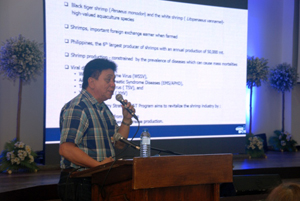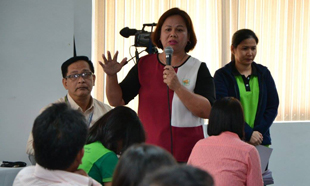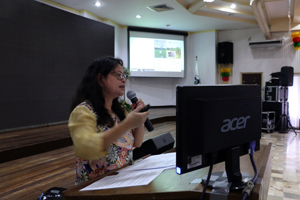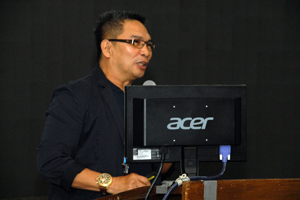 The forum, which was part of the three-day SIPAG FIESTA, was spearheaded by the Philippine Council for Agriculture, Aquatic and Natural Resources Research and Development of the Department of Science and Technology (DOST-PCAARRD).
The forum, which was part of the three-day SIPAG FIESTA, was spearheaded by the Philippine Council for Agriculture, Aquatic and Natural Resources Research and Development of the Department of Science and Technology (DOST-PCAARRD).
Showcasing the best of the Council’s R&D initiatives from 2010 to 2016, SIPAG FIESTA provided a technology forum where important outputs on crops, livestock, aquatic, forestry, natural resources were tackled.
Aquatic technologies
Aquatic experts from the University of the Philippines Visayas (UPV), Southeast Asian Fisheries Development Center (SEAFDEC), and UP Diliman-Marine Science Institute (UPD-MSI) discussed their respective research outputs.
Prof. Valeriano L. Corre, Jr. of the University of the Philippines in the Visayas, discussed the use of a disease diagnostic kit for detecting white spot syndrome virus (WSSV) and other shrimp pathogens.
Corre also discussed the biofloc technology, which uses multiple layers of microorganisms in water to enhance nutrition and control disease of shrimp.
Dr. Emilia T. Quinitio, Head, Dumangas Brackishwater Station of the Southeast Asian Fisheries Development Center (SEAFDEC) Aquaculture Department discussed the opportunities in mangrove crab as an export commodity, the use of marine annelid to ensure mangrove crab’s nutritional requirement, as well as the production of high value soft-shell crab. Marine annelid is a formulated diet, which contains higher levels of total lipids and highly unsaturated fatty acid that can improve larval performance.
Dr. Aletta T. Yniguez of the University of the Philippines Diliman-Marine Science Institute provided information about the Benham Rise, a deep-water biodiversity hotspot located off the coast of Aurora province and its exploration which was funded by DOST-PCAARRD.
Livestock technologies
Significant outputs under the Industry Strategic S&T Plan (ISP) as discussed during the forum include slaughter goat, dairy goat, native chicken, duck, pork, dairy buffalo, and feed resources.
The Goat ISP led to the development of the Farmer Livestock School on Goat Enterprise Management (FLS-GEM), an e-learning course on goat and artificial insemination (AI) system
 “FLS-GEM has benefited 214 technicians, 485 farmers, and 831 entrepreneurs,” according to Anna Marie P. Alo, Supervising Science Research Specialist, Livestock Research Division (LRD), PCAARRD.
“FLS-GEM has benefited 214 technicians, 485 farmers, and 831 entrepreneurs,” according to Anna Marie P. Alo, Supervising Science Research Specialist, Livestock Research Division (LRD), PCAARRD.
Dr. Synan S. Baguio, LRD Officer-in-Charge, discussed native chicken production.
“Free range production protocols for four native chicken strains, including Darag, Camarines, Manok Bisaya, and Zampen,” were developed under the Native Chicken ISP,” Baguio explained.
The program was also able to develop ethnobotanical anthelmintics and Newcastle Disease (NCD) vaccine to control gasto-intestinal parasitism and the annual NCD outbreaks, which cause 90% mortality in native chicken flocks.
Forestry and natural resources technologies
 Dr. Ma. Victoria O. Espaldon of the UPLB-School of Environmental Science and Management tackled the topic Smarter Approaches to Reinvigorate Agriculture as an Industry (SARAI) in the Philippines.
Dr. Ma. Victoria O. Espaldon of the UPLB-School of Environmental Science and Management tackled the topic Smarter Approaches to Reinvigorate Agriculture as an Industry (SARAI) in the Philippines.
SARAI aims to provide a decision support system for farmers in dealing with the effects of climate change in the agricultural sector using advances in S&T.
Dr. Rex Victor O. Cruz, a forestry and natural resources sector expert of UPLB discussed watershed management for climate resiliency for a sustainable agri-aqua industry.
Crops technologies
The Crops Research Division (CRD) led the forum for the crops sector, which focused on six commodities: abaca, mango, rice, banana, coconut, and peanut.
Dr. Gil Magsino of the University of the Philippines Los Baños-National Crop Protection Center (UPLB-NCPC) discussed radiation-modified carrageenan plant growth promoter (PGP) in rice.
The technology produced 15-30% average increase in rice yield in multi-location trials conducted in Bulacan, Nueva Ecija, Laguna, and Iloilo.
 Dr. Olivia P. Damasco of UPLB-Institute of Plant Breeding and Dr. Lourdes C. Generalao of the University of Southeastern Philippines (USeP) discussed irradiated Lakatan, a technology that addresses banana bunchy top virus (BBTV) and Fusarium Wilt Tropical Race 4 through varieties and biological control, respectively.
Dr. Olivia P. Damasco of UPLB-Institute of Plant Breeding and Dr. Lourdes C. Generalao of the University of Southeastern Philippines (USeP) discussed irradiated Lakatan, a technology that addresses banana bunchy top virus (BBTV) and Fusarium Wilt Tropical Race 4 through varieties and biological control, respectively.
AAFNR techno forum
Jose Tomas M. Cabagay, Supervising Science Research Specialist, Technology Transfer and Promotion Division (TTPD) discussed the prospects of agribusiness entrepreneurship for high school graduates.
Cabagay stressed that unemployment in the country can be reduced if Filipinos would consider getting into agribusiness or get self-employed.
Dr. Melvin Carlos, TTPD Director, encouraged students to pursue tertiary and post-graduate courses specializing in agriculture, aquatic, forestry and natural resources disciplines in order to fill up the lack of professionals in the field.
“The country is faced with the concern of having more than 3,000 ageing researchers and scientists in the said sectors,” Carlos said.
